Basically I've got a QGridLayout with a few widgets in it. The important ones are 2 labels, which I use for drawing images to the screen. Well, if the user wants, he can change the resolution of the incoming images, thus, forcing the Labels to resize.
Let's assume the initial size of the label is 320x240. The user changes the VideoMode to 640x480, the label and the entire GUI resizes perfectly. But when the user switches back to 320x240, the label shrinks, but the Layout/Window does NOT.
I've played around with sizePolicies and sizeHints, and resize(0,0), but nothing did the trick. Could somebody help me with this?
Here some screenshots to clarify the problem:


